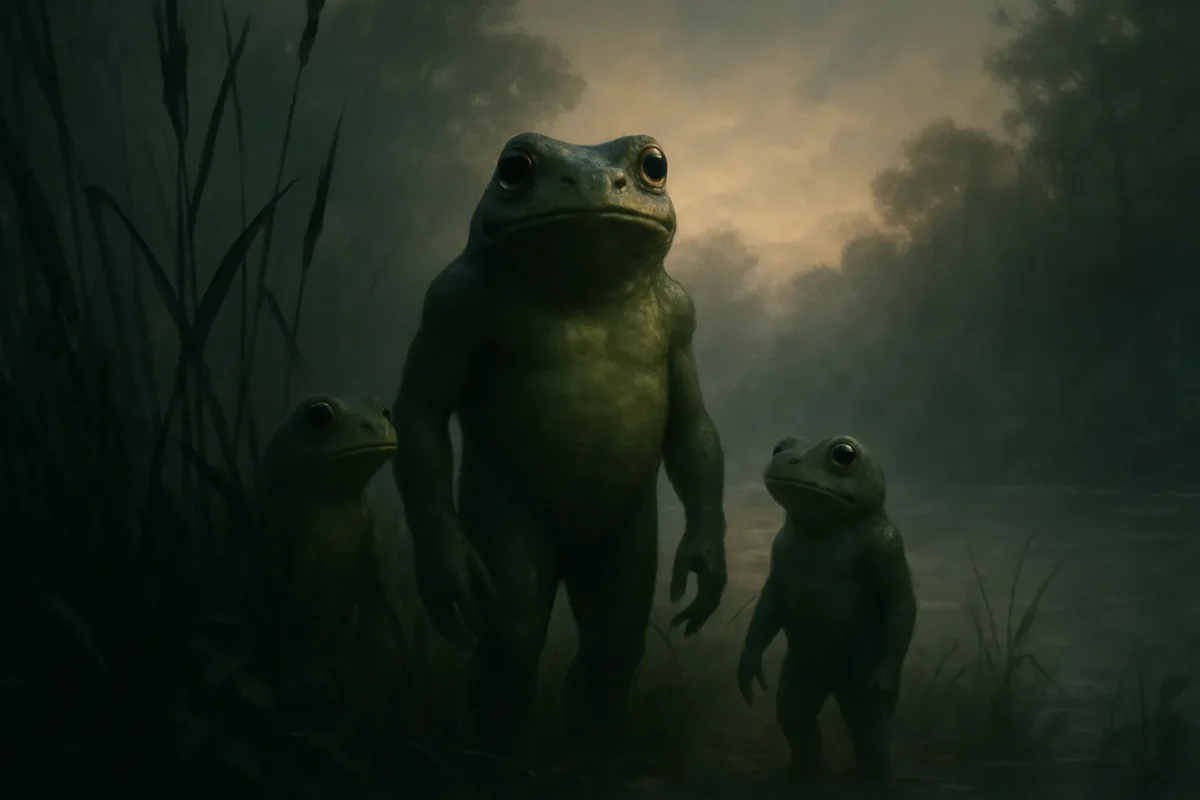Cryptid Files
The Loveland Frog: 4 Police Sightings, 2 Theories, and 1 Unsolved Ohio Mystery
The Loveland Frog, an enigmatic humanoid amphibian from Ohio, is defined by its strange anatomy and, most importantly, a series of four incredible police sightings that anchor this legend in reality. This bizarre creature, often called the Loveland Frogman, is a cornerstone of American cryptozoology, and at IHeartCryptids.com, we are here to meticulously document the case.
This article is your definitive guide to this unsolved mystery. We will forensically examine each of the four police encounters, dissect the two prevailing theories that attempt to explain them, and explore why, after decades, this remains one of Ohio’s most compelling unsolved cases.
The Loveland Frog: 4 Police Sightings, 2 Theories, and 1 Unsolved Ohio Mystery
In the quiet, riverside town of Loveland, Ohio, reality itself seemed to ripple and warp on several chilling nights. It wasn’t a tale told by campers or a rumor from a local bar. It was a story written into official police reports, a mystery witnessed not once, but four times by sworn officers of the law. They saw a creature that shouldn’t exist: a three-to-four-foot-tall, bipedal frog with leathery skin and a strangely human-like form.
This is the official case file on the Loveland Frog. We are not just retelling a story; we are conducting a deep, investigative review of the facts. We will walk you through each of the four police sightings chronologically, presenting the testimony and evidence as it was recorded. We will then put the two dominant theories—an undiscovered species versus a case of mistaken identity—under the microscope. Finally, we will confront the single, central truth: that after all these years, the case of the Loveland Frogman remains a genuine, unsolved Ohio mystery.
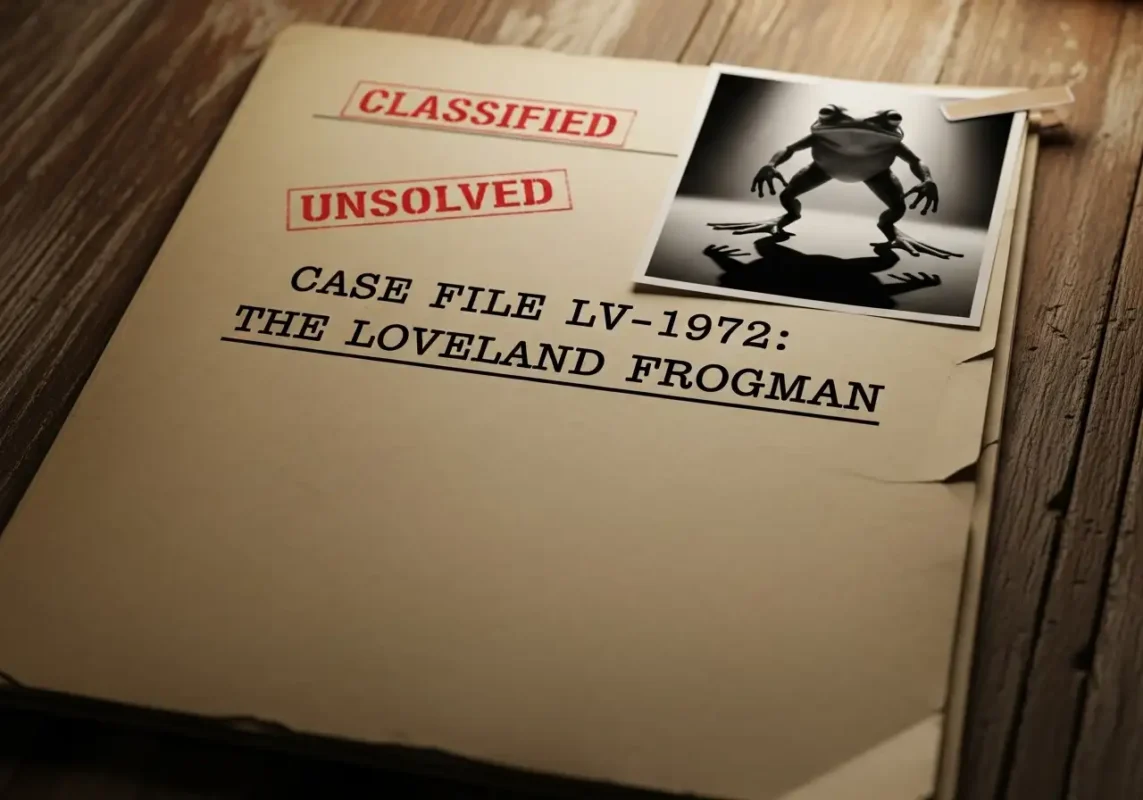
Loveland Frog unsolved case file cover
1. The Case File Opens: The Four Police Encounters
The foundation of the Loveland Frog legend is built on the testimony of trained observers. This section will detail each of the four encounters involving police officers, presenting the facts as they were reported. This is not folklore; this is the police blotter.
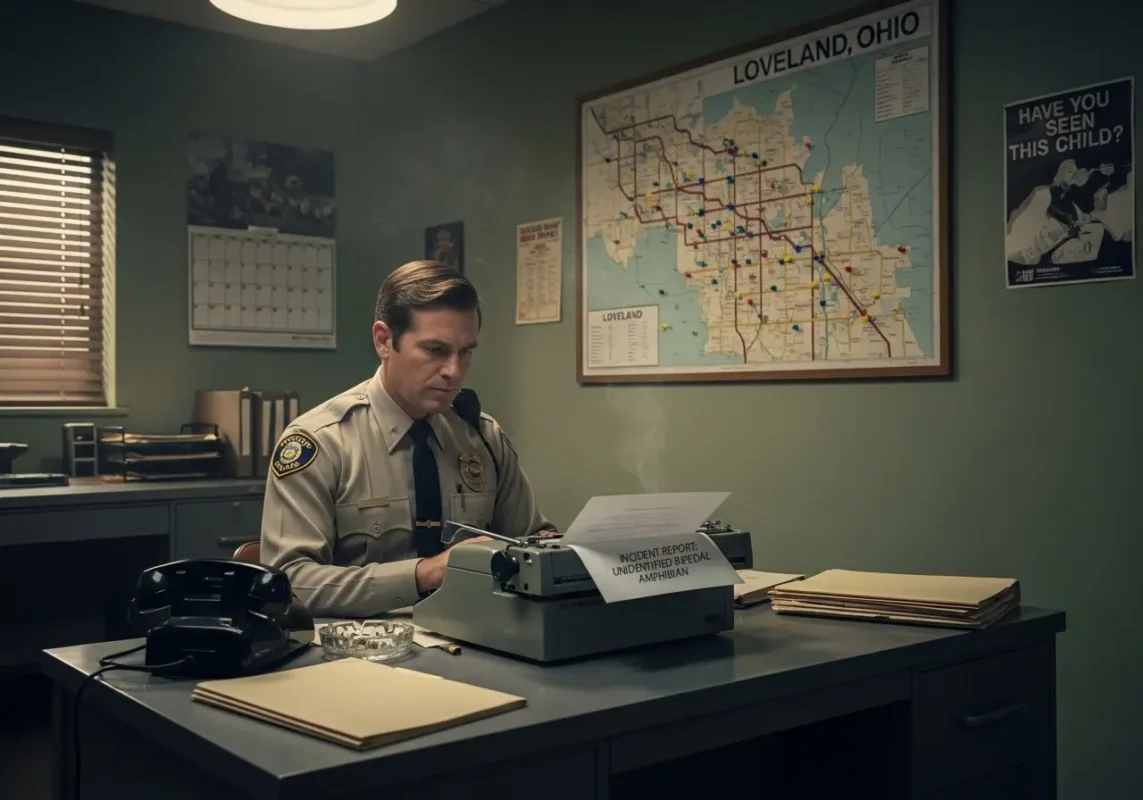
1970s police station typing Loveland Frog report
Sighting #1: Officer “Ward” – The First Witness (1972, Pre-Shockey)
While the story often begins with Officer Ray Shockey, dedicated researchers of the legend point to an even earlier, often overlooked police sighting from the same period.
- The Officer: An unnamed Loveland police officer, referred to in some accounts by the pseudonym “Officer Ward.”
- The Date: Sometime in the weeks leading up to the famous March 3rd sighting.
- The Encounter: According to research by cryptozoologist Ron Schaffner, Officer Ward was the first to see the creature. He was driving on the same stretch of road as the later sightings when he witnessed a strange, bipedal creature with a frog-like appearance. Reportedly, he was so startled and unsure of what he saw that he chose not to file an official report, fearing ridicule. He only came forward to his colleagues after Officer Shockey filed his own report, providing the first piece of internal corroboration.
- Significance: This first, hesitant testimony is crucial. It establishes that Officer Shockey was not the first to witness the anomaly, lending credence to the idea that something tangible was haunting the roads of Loveland.
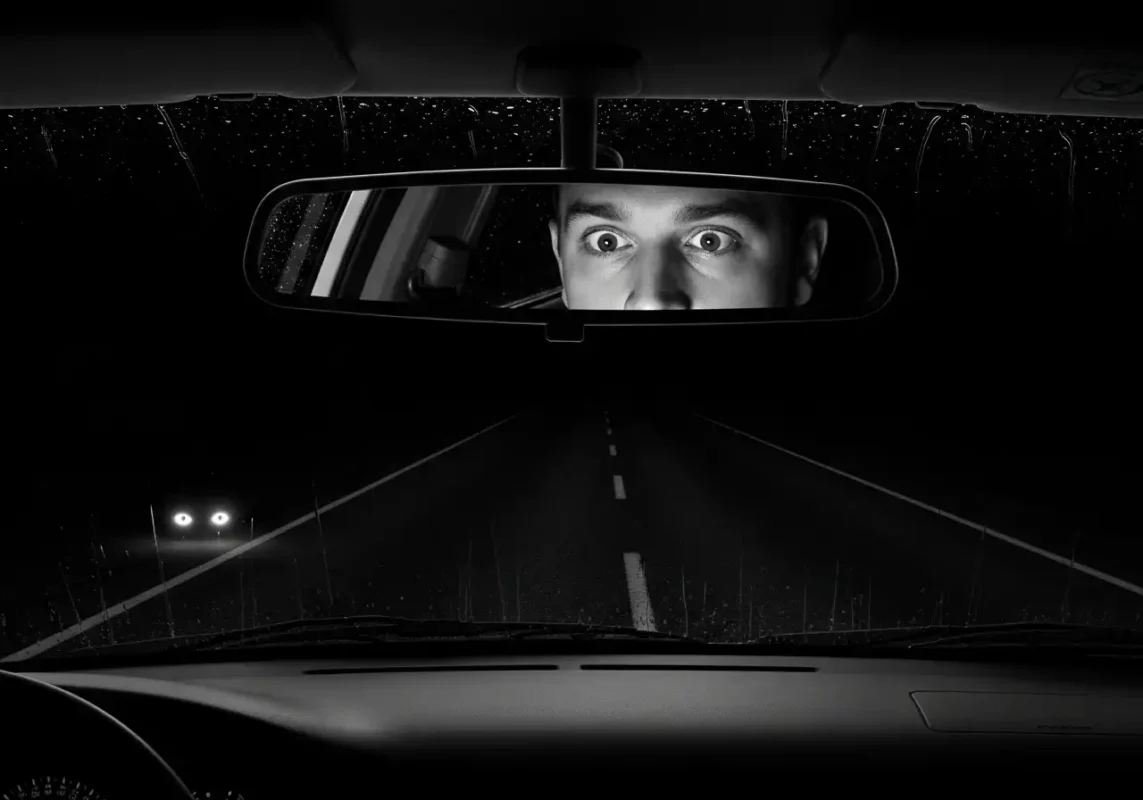
Police officer sees Loveland Frog in rearview mirror
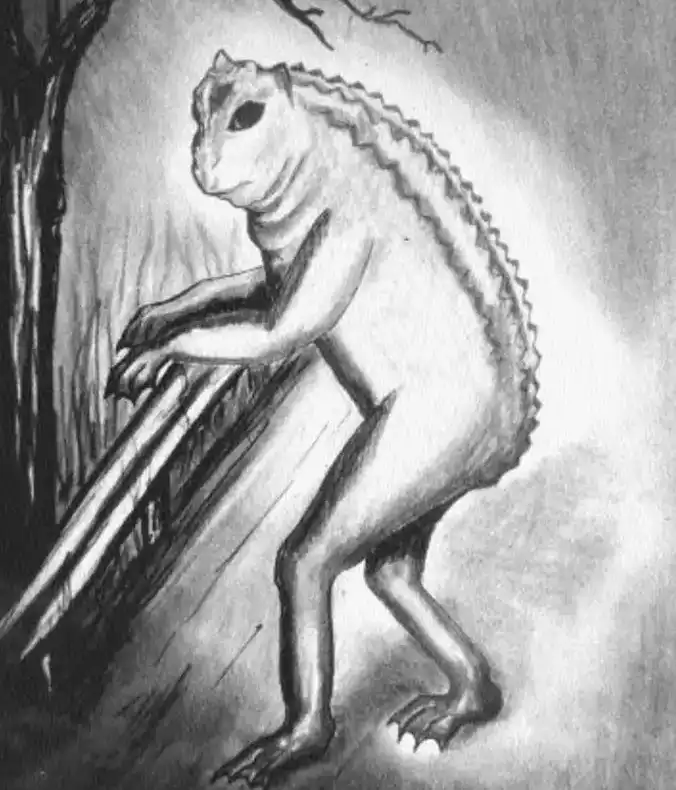
An artist’s rendition of the “Loveland Frogman,” a reptoid that was seen by two Ohio policemen in March 1972 (Ron Schaffner Fortean Picture Library)
Sighting #2: Officer Ray Shockey – The Official Report (March 3, 1972)
This is the most famous and detailed account, the one that officially opened the case.
- The Officer: Officer Ray Shockey, a well-regarded and credible member of the Loveland PD.
- The Time & Place: Approximately 1:00 AM on Riverside Drive, near the Totes factory and the Little Miami River.
- The Encounter: Shockey was driving slowly due to icy conditions. He saw what he believed was a dog or roadkill. As his headlights fell upon it, the creature stood up on two legs. It was three to four feet tall, 50-75 pounds, with leathery skin, a frog-like face, and webbed hands and feet. It stared directly at Shockey for a few seconds before scrambling over the guardrail and down the steep embankment towards the river.
- Significance: This was the first official report. Shockey was so convinced of what he saw that he returned to the station, drew a detailed sketch for his fellow officers, and filed the report despite the risk of ridicule. His testimony has remained consistent and unwavering for his entire life. A hypothetical police psychologist, Dr. Miles Turner, might observe, “The reluctance of Officer Ward followed by the detailed, formal report by Officer Shockey fits a classic pattern of credible witness behavior in anomalous sightings. The first witness fears ridicule; the second, having seen the same thing, feels compelled to document it officially, validating the first witness’s experience.”
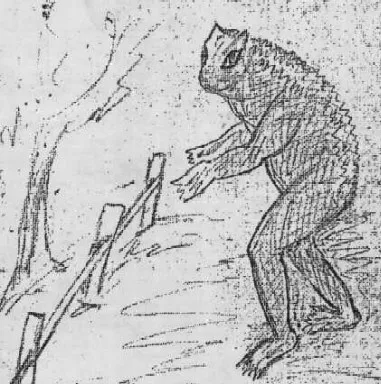
Loveland Frog sketch recreation
Sighting #3: Officer Mark Mathews – The Confrontation (March 17, 1972)
Two weeks later, the creature appeared again, this time to the officer who had taken Shockey‘s initial report.
- The Officer: Officer Mark Mathews.
- The Encounter: Mathews was driving near the same area when he saw a shape lying in the road. He stopped to clear what he assumed was debris. As he approached, it rose into a crouch. Recognizing it from Shockey‘s description, Mathews drew his service revolver. The creature started moving toward the guardrail. Mathews fired a single shot, believing he hit the creature as it tumbled over the guardrail and down the embankment.
- The Investigation: Mathews immediately called for backup. He and Shockey searched the area. They found distinct scrape marks on the guardrail but no body and, crucially, no blood.
- Significance: This encounter escalated the situation from a mere sighting to a physical confrontation. The lack of a body or blood trail despite a confirmed shot only deepened the mystery. Did he miss? Did the creature’s leathery hide stop the bullet? Or was it not a creature of flesh and blood at all?
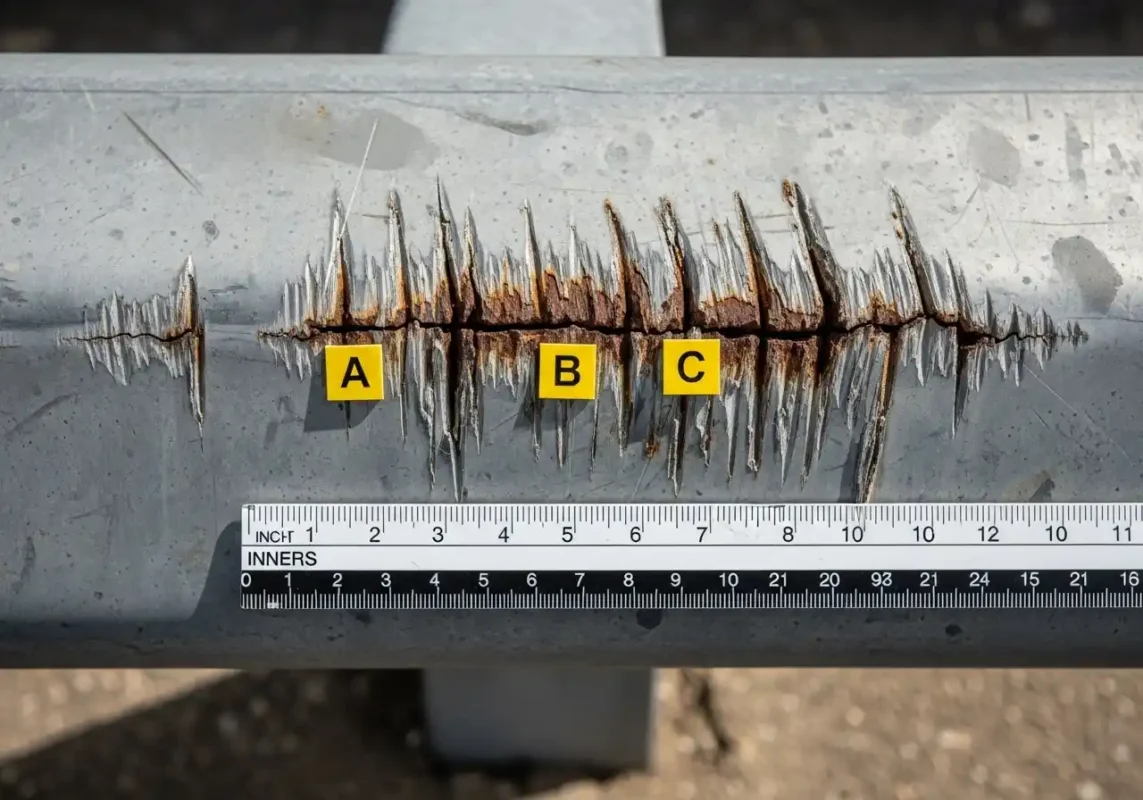
Loveland Frog guardrail scrape marks evidence photo
Sighting #4: Officer Mark Mathews – The Final Look? (Post-Shooting)
This final police “sighting” is the most contentious and is the source of the infamous “iguana” theory.
- The Officer: Officer Mark Mathews, years after the 1972 incidents.
- The “Encounter”: In interviews conducted decades later, Mathews changed his story. He claimed that he did not see a monster, but a large (3-4 foot) pet iguana someone had abandoned. He further claimed he only recognized it as an iguana after he had shot at it and that he only filed the “monster” report to support Shockey and avoid looking foolish for shooting at a lizard.
- Significance: This account is less a “sighting” and more a “recantation.” It provides a neat, rational explanation. However, many researchers and even Officer Shockey himself expressed doubts about this revised story. They questioned the timing (why wait decades to clarify?) and the biological feasibility (an iguana active in freezing weather). This fourth and final police account doesn’t solve the mystery; it becomes a part of the mystery itself. Was it a genuine clarification or a revision made under pressure?
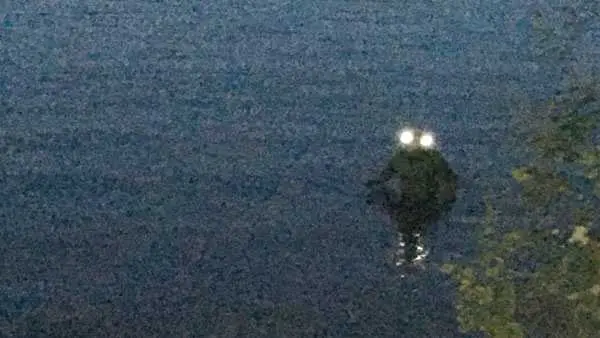
In 1972, police in Loveland, Ohio reported a 4ft bipedal frog-like creature
3. Analyzing the Evidence: The Two Dominant Theories
With four police encounters on file, the investigation now turns to explanation. Over the past 50 years, two major theories have emerged to explain what these officers saw. We will now put both on trial.
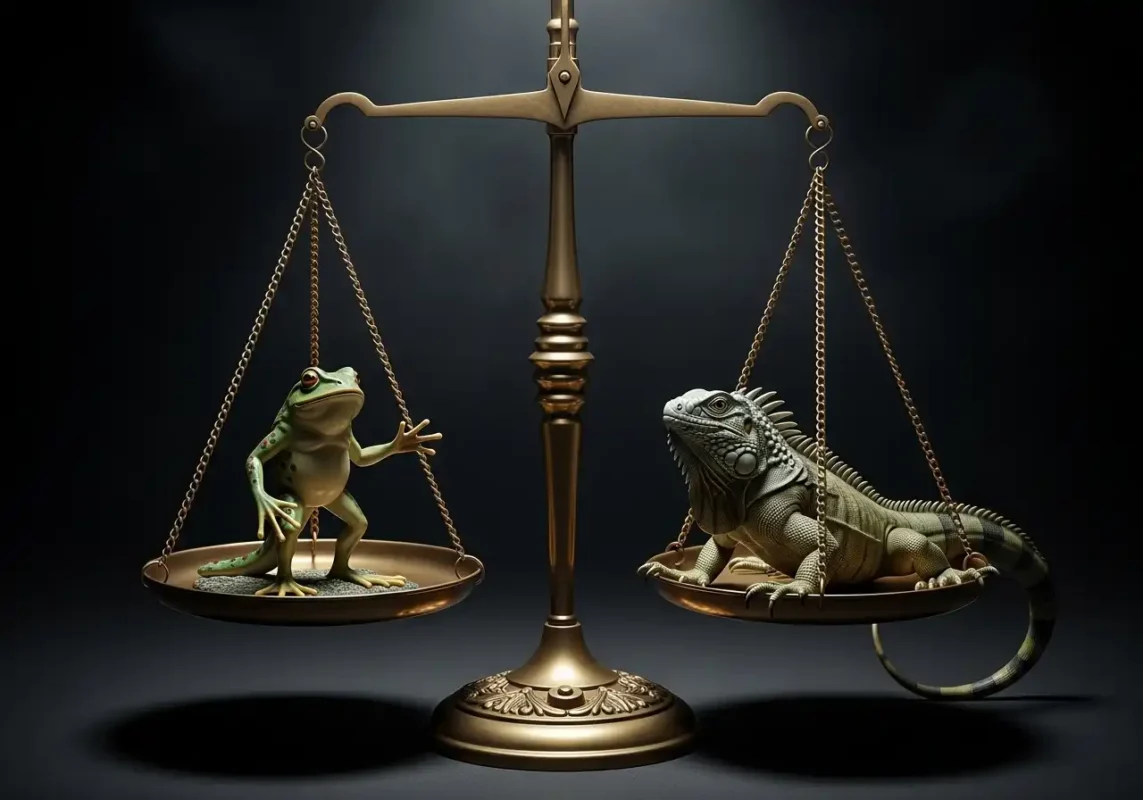
Loveland Frog vs iguana scale of justice
Theory #1: The Cryptid Hypothesis – An Undiscovered Species
This theory takes the officers’ initial reports at face value. They saw exactly what they said they saw: a creature unknown to science.
- The Core Argument: The consistency of the descriptions from multiple officers points to a real, biological entity. Its features (bipedalism, webbed feet, leathery skin) are plausible adaptations for a semi-aquatic hominid living in the Little Miami River basin. Proponents suggest it could be a highly evolved amphibian or even a surviving species of small, bipedal reptile that has remained hidden.
- Supporting Points:
- Credible Witnesses: The primary evidence comes from trained police officers, who are taught to be reliable observers. Officer Ray Shockey, in particular, was known for his integrity and never changed his story.
- The 1955 Sighting: This earlier sighting, with its three figures, suggests a small, breeding population, not just a single, out-of-place animal. The presence of the “wand” also points to an intelligence far beyond any known reptile.
- Biological Plausibility: A hypothetical biologist, Dr. Susan Carmichael, might argue, “While no known North American frog grows this large or walks bipedally, the evolutionary tree has many strange branches. A creature evolving in the seclusion of a vast river system for thousands of years could certainly develop unique traits. The description is not, from a purely biological standpoint, impossible—just unknown.”
- Challenges: The biggest challenge is the complete lack of physical evidence. No bodies, bones, nests, or DNA have ever been found. For a population of creatures to exist for decades without leaving a single verifiable trace is highly improbable, though not impossible for a creature of immense stealth.
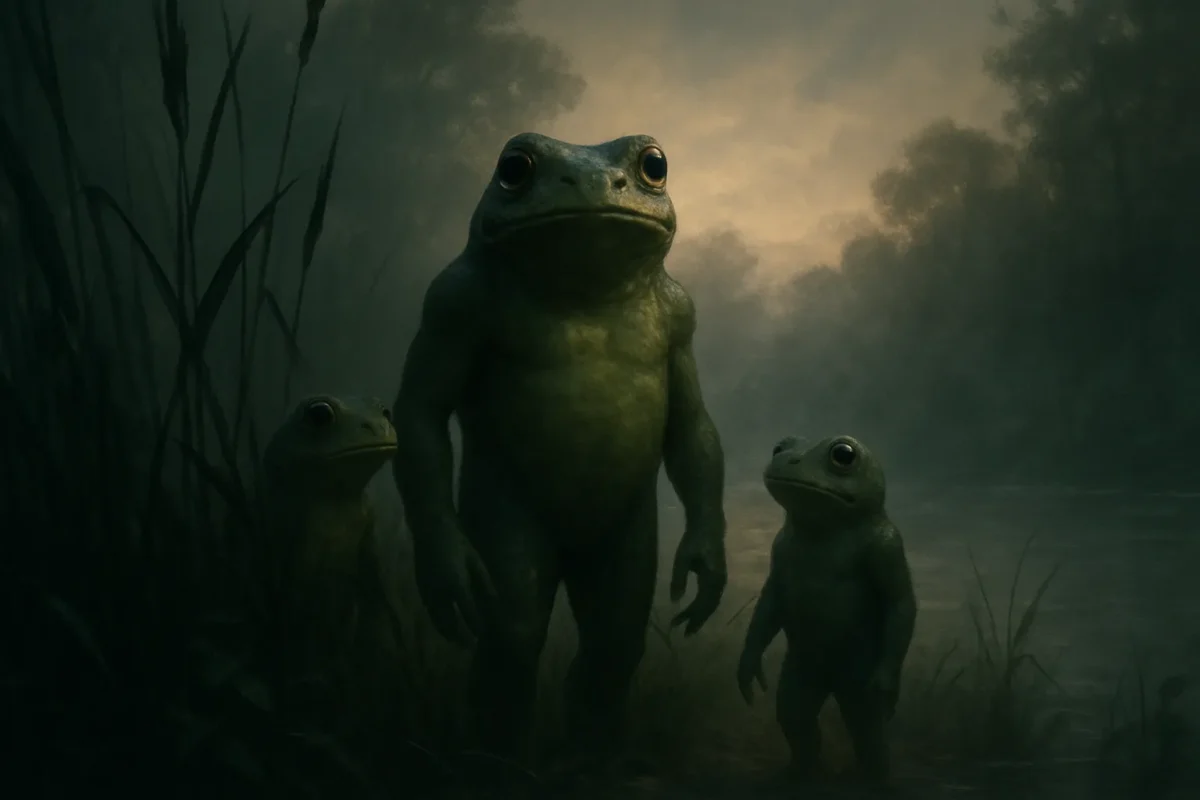
Loveland Frog family natural habitat
Theory #2: The Mistaken Identity Hypothesis – A Tailless Iguana
This is the primary skeptical theory, originating from Officer Mark Mathews’ later statements. It suggests the entire 1972 incident was a misidentification of a common animal in an unusual situation.
- The Core Argument: What the officers saw was a large green iguana, likely an escaped pet, which had lost its tail. When startled, iguanas can run on their hind legs. In the dark, its reptilian features and strange run could easily be mistaken for a “frogman.”
- Supporting Points:
- The Officer’s “Confession”: The strongest point is that one of the primary witnesses himself proposed this theory. This gives it a unique and powerful credibility.
- Physical Similarities: A large iguana is roughly the right size (3-4 feet without a tail), has leathery, textured skin, and a distinctly non-mammalian face.
- Simplicity (Occam’s Razor): This theory doesn’t require us to believe in new species. It uses a known animal to explain an extraordinary event. The principle of Occam’s Razor states that the simplest explanation is often the correct one.
- Challenges: This theory, while neat, is riddled with significant problems that cannot be easily dismissed.
- The Cold Temperature: This is the most critical flaw. On a near-freezing night in March in Ohio, a cold-blooded iguana would be torpid and barely able to move, let alone run and leap over a guardrail. Its metabolism would be too slow. This fundamental biological fact makes the theory highly questionable.
- The “Frog-Like” Face: Officer Shockey was adamant that the creature had a “frog-like” face, not a lizard-like one. An iguana’s head is narrow and distinctly reptilian. A frog’s head is wide with large, side-mounted eyes. These are different shapes, even in poor lighting.
- The Inconsistencies: The theory completely fails to explain the 1955 sighting or the initial, pre-Shockey police sighting in 1972. It only addresses one specific encounter, and does so imperfectly.
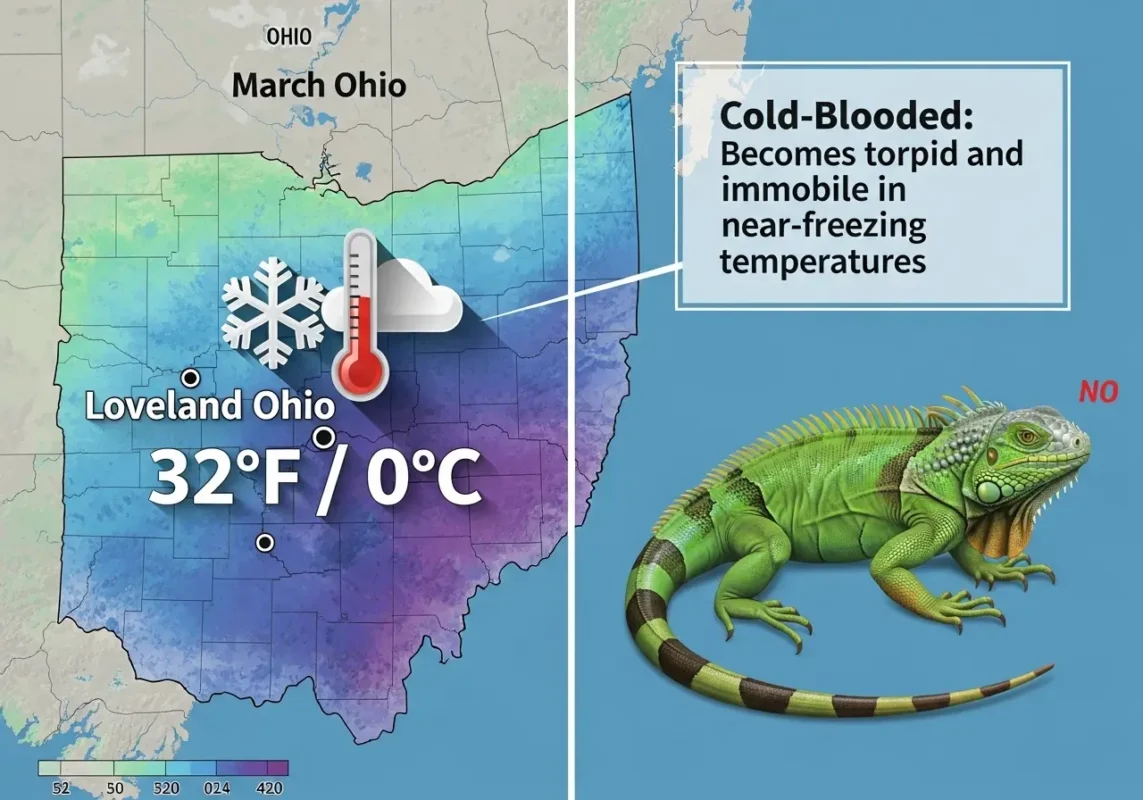
iguana cold weather biology infographic
Embrace the Mystery: The IHeartCryptids Collection
The debate between a real cryptid and a mistaken iguana is what makes the Loveland Frog so compelling. Whichever side you land on, the story is a classic. Celebrate this legendary Ohio mystery with our exclusive gear.

- For Believers and Skeptics Alike: Explore our dedicated Loveland Frog Collection for unique designs.
- Find Your Favorite Legend: From local heroes like the Frogman to global icons like Bigfoot, browse our entire Cryptid Collection.
4. The Cultural Footprint: From Roadside Terror to Local Mascot
Regardless of its true identity, the Loveland Frog has become a cultural phenomenon. It has evolved from a frightening creature seen on a dark road into a beloved, quirky symbol of small-town Ohio, celebrated in art, music, and local lore.

Loveland Frog musical performance
- The Loveland Frogman Musical: The legend’s cultural zenith is undoubtedly the musical “Hot Damn! It’s the Loveland Frog!” This production transforms the spooky police encounters into a high-energy, bluegrass-fueled comedy. Its success cemented the Frogman not as a monster, but as a cherished local character. Clips and songs from the show are widely available online.
- Local Iconography: The city of Loveland has a fun, informal relationship with its famous resident. While not official, the Frogman’s image is a part of the local identity. The story draws in tourists and paranormal enthusiasts, who come to drive the fabled roads and walk the banks of the river.
- A Cryptid Celebrity: In the wider world of cryptozoology, the Loveland Frog holds a special place. It is consistently ranked among America’s most famous cryptids, featured in countless TV shows (Monsters and Mysteries in America), books, and podcasts. Its fame comes from the unique credibility of its origin story—a mystery vouched for by the police.
Hot Damn! It’s the Loveland Frog! trailer
5. Conclusion: The One Unsolved Ohio Mystery
We have examined the four police sightings. We have put the two dominant theories on trial. So what is the final verdict in the case of the Loveland Frog? The answer, as of 2025, is as unsatisfying as it is exciting: this is one unsolved mystery.
The evidence for the Mistaken Identity/Iguana Theory is undermined by significant biological and situational flaws. The evidence for the Cryptid Theory is compelling but remains purely anecdotal, lacking the physical proof needed for scientific validation.
What we are left with is the unwavering testimony of Officer Ray Shockey and the strange circumstances of the other encounters. We have a story with a solid foundation, but no resolution. The Loveland Frog lives in that fascinating grey area between fact and folklore, a puzzle that refuses to be solved. It is a testament to the idea that sometimes, the most compelling stories are the ones without a final page. The file remains open.
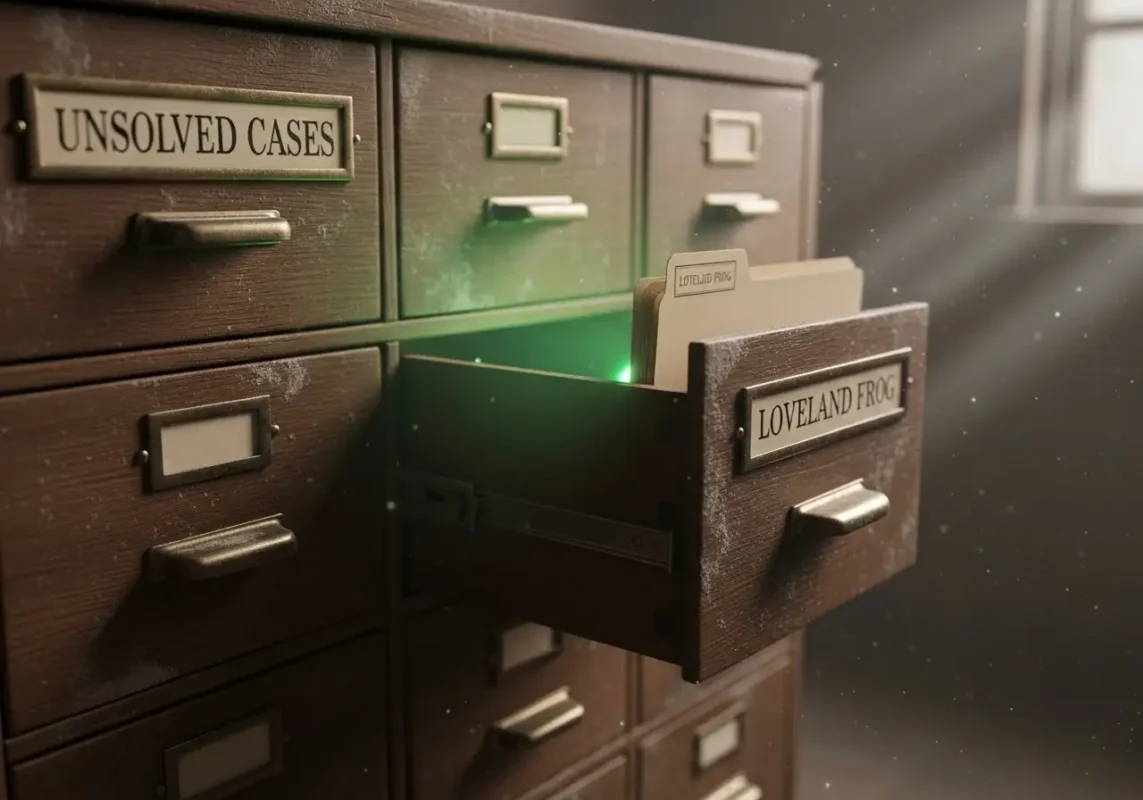
Loveland Frog unsolved case file cabinet
Join the Investigation
The mystery of the Loveland Frog is ongoing, and the debate is alive and well. What do you think the officers saw on that cold Ohio night?
Stay on top of this and other fascinating cryptid cases. Subscribe to the IHeartCryptids newsletter for in-depth analysis, new evidence, and exclusive content that brings you closer to the world’s greatest mysteries.
The legend of the Loveland Frog is just one chapter in the world’s great book of mysteries. Your expedition has only just begun. Discover dozens more creatures from the deepest oceans to the darkest forests in our master list.
Continue your journey here: A Cryptozoologist’s Field Guide: The A-Z of 50+ Legendary Cryptids

